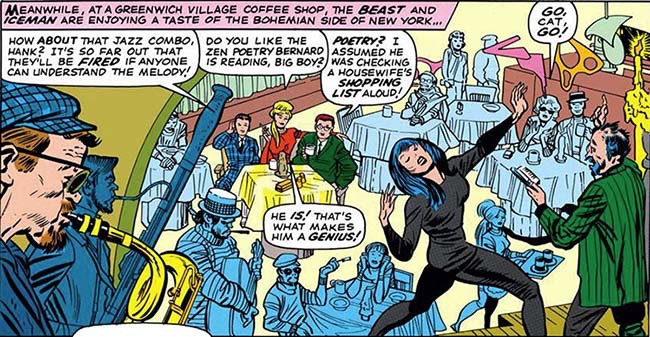2020-06-21
***
# CONTENTS
## READING
## MUSIC AND RISK
## STATISTICALLY IMPROBABLE
## ETERNAL PRESENT
***
## READING
I am taking on Concordia’s Graphic Novel course in the fall and am rebuilding the entire thing.
Bart Beaty and Benjamin Woo’s The Greatest Comic Book of All Time:
Symbolic Capital and the Field of American Comic Books has been enormously helpful, as has Beaty’s Comics versus Art. The latter patiently explains why various formalist definitions of comics in general and the graphic novel in particular all fail: the term “graphic novel” only makes sense discursively. That is, because all of the existing definitions end up excluding important examples in some way, you have to look at who uses the term, and its historical and geographic contexts, in order to figure out why they’re using it. For Beaty and Woo, the term is largely aspirational — that is, over the last half of the 20th century, it appears consistently in arguments about how and why comics can “do more” in their attempt to escape from their lowbrow status. The former uses a variety of approaches, including cultural analytics, to interrogate various sacred truths about the comics canon that has emerged since the 1980s.
These are compelling, carefully argued books. I don’t agree with everything in them, of course (I have some things to say about their argument about Martin Vaughn-James’ The Cage, for example), and neither will you, but they scratch a lot of my itches.
## MUSIC AND RISK
I was trying to remember the last time I cared about an album, which is a more interesting question than what that album was. What I realized was that one reason that I don’t care as much any more is that thew risk in discovering new music is much, much lower than it was when I first started buying LPs in the 1970s.
Before I had a job, an album cost several weeks of allowance. I might get one on my birthday, but a poor choice was worse than a new pair of socks because it reflected on my poor taste rather than someone else’s.
After I had my first job, an album was still at least two hours’ worth of wages. To make that kind of investment, the payoff had to be substantial in terms of both the content (did it have enough good songs?) and the cultural capital accrued from my friends by boasting that I’d just bought it. Once I had a cassette deck, in high school, saving up for a box of UDXLII-90s, each of which could usually contain a full album on each side, took longer but was far more cost-effective.
Buying and taping both required discernment. You bought or taped what you heard on the radio or what your friends had played for you because it called to you — that is, you did it to fit in to some sort of ideological imperative. But doing research outside those envelopes required more expense and more risk, in the form of buying and reading music magazines.
The year after I graduated from high school, Spin appeared, and it was my bible. Spin sharpened my taste for punk, then taught me about alternative, hip hop and afrobeat.
By the end of my undergrad years, I was sneak-reading MAXIMUMROCKNROLL and NME off the record store shelves (too much money to buy them). It turned out that punk was for rich kids because the albums were even harder to find and more expensive than usual.
MP3s removed desire, because there was such a glut of them, but they still took effort to find, download, tag and sort. I was told by a lawyer friend who works on corporate IP at high levels that music companies consider Generation X a lost cause. They sold us all our favourite music two or three times — first on LP, then on CDs and then remastered special editions. When MP3s came along, they knew we’d never buy anything again. So they played the long game and built vertically integrated platforms to capture the next generations.
Spotify strips away the risk involved in learning about anything that’s ever been commercially released. What’s not on Spotify I can locate quickly on YouTube. During the BitTorrent years, I listened almost exclusively to bootlegs and live recordings, but have lost track of that world mostly out of sloth; it’s just easier to stream because my phone is always in my pocket.
But with no risk involved in learning about new music, I have to invest less, so I care less.
The only consolation in all of this is I can play music for my kids that was never popular because it’s never been on the radio. And never will be. Still, they think that Rollins singing “Do It” by the Pink Fairies is hilarious. Which counts for something. I think.
## STATISTICALLY IMPROBABLE
Every time I feel like writing a poem I jam two words that don’t belong together, and I take a little trip to one of the sites on the edge of the Web. I look at it for a couple of minutes, and say, nah.
Turns out language poetry was formally identical to the results of the algorithms Amazon now uses for identifying individual texts (SIPs), and the contents of the pages that honeypots use to mislead web searches by humans and nonhumans alike to generate a little extra traffic.
Neil Hennessy and Bill Kennedy and I talked about this many years ago, when we were interested in a program called Sugarplum. Neil ended up writing a paper about it. When I told Bruce Andrews that we could replace him with a few lines of Perl, he was not amused.
So langpo poetics was correct: their writing really was all about the economy. The problem was they were looking at it from the parallax view. What we got was not more democratic poems that invited the reader to contribute to the production of meanings, but autocratic algorithms that surveilled, sorted and ultimately produced us as networked consumers.
“As one knows without saying, we do not write anymore” — F. A. Kittler
## ETERNAL PRESENT
The truth of The Autobiography of Alice B. Toklas is The Bourne Identity.

